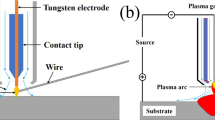Abstract
Friction welding is one of the most effective and widely used solid-state joining methods in modern industries. Plastic deformation of interface material is the essence of friction welding, and welding process parameters affect the welding quality greatly. To understand the friction welding process better, it is important to calculate the temperature, stress, and strain fields of welding interface material in the welding process. In this paper, continuously driven friction welding of Al-Cu-Mg alloy round bars that are commonly used in aerospace structures are calculated with the finite element method (FEM). FEM calculations and results are explained and discussed in much detail. For example, depending on experiments as reference, FEM results show that a temperature of 490 °C, which is below the low value of Al-Cu-Mg alloy melting point, is obtained at the end of 0.6 s of friction welding. During the whole process of friction welding, the calculated equivalent strains increase monotonously, and the equivalent strain at the center of circular section of interface material is the largest.
Similar content being viewed by others
References
A. Sluzalec, Thermal Effects in Friction Welding,Int. J. Mech. Sci., 1988,32(6), p 467–478
G.J. Bebdzsak, T.H. North, and Z. Li, Numerical Model for Steady-State Flow in Friction Welding,Acta Mater., 1997,45(4), p 1735–1745
L. Fu and L. Duan, The Coupled Deformation and Heat Flow Analysis by Finite Element Method During Friction Welding,Weld. Res., 1998 (Suppl), p 202–207
L. D’Alvise, E. Massoni, and S.J. Walløe, Finite Element Modelling of the Inertia Friction Welding Process Between Dissimilar Materials,J. Mater. Process. Technol., 2002,125–126, p 387–391
C.M. Chen and R. Kovacevic, Finite Element Modeling of Friction Stir Welding—Thermal and Thermomechanical Analysis,Int. J. Machine Tools Manuf., 2003,43, p 1319–1326
M. Sahin, Simulation of Friction Welding Using a Developed Computer Program,J. Mater. Process. Technol., 2004,153–154, p 1011–1018
L. Fuguo, N. Lei, L. Qinghua, and D. Ligu, Microstructure Simulation and Prediction of IN-718 Superalloy in Inertia Friction Welding,Trans. China Welding Inst., 2002,23(1), p 30–33, in Chinese
Author information
Authors and Affiliations
Rights and permissions
About this article
Cite this article
Li, Q., Li, F., Li, M. et al. Finite element simulation of deformation behavior in friction welding of Al-Cu-Mg alloy. J. of Materi Eng and Perform 15, 627–631 (2006). https://doi.org/10.1361/105994906X150821
Received:
Published:
Issue Date:
DOI: https://doi.org/10.1361/105994906X150821




